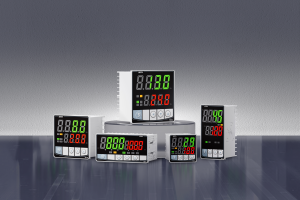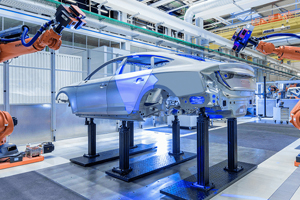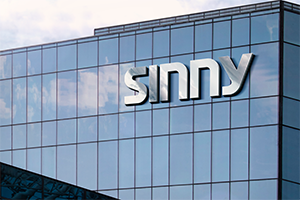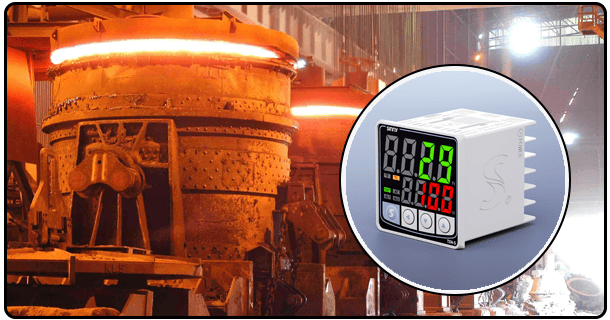How to implement a software-based PID temperature controller
1. Definition of software-based PID control
Precision temperature regulation is a requirement for a wide range of applications. From sensitive lab experiments that require microkelvin stability, to industrial processes with tight tolerances or complex environments requiring consistent material properties in 3D printing. To accurately achieve and maintain a temperature profile, a sophisticated strategy is required. Among the most effective methodologies available, the PID (Proportional-Integral-Derivative) control algorithm stands out as a cornerstone technique. The mathematical method, which is designed to reduce the difference between the desired setpoint value and the process variable's actual value, is the foundation of most temperature control systems. Typically, a PID temperature controller utilizes dedicated hardware, often a microprocessor-contained unit, to execute the algorithm and manage the control loop in real-time. A more flexible and powerful solution involves the implementation of PID logic in software running on general purpose computers, dedicated microcontrollers, or hardware designed specifically for computing tasks. The software-based PID temperature controller uses the flexibility and computational power of the software for the management function. The PID algorithm is executed on a processor unit that interfaces with the temperature sensors and actuators via digital communications. Software-based PID controls are essential to engineers, researchers, and hobbyists who want sophisticated and adaptable temperature automation. This guide explores the basic aspects of implementing a software-based temperature control system.
2. The Core Components for a PID Software System
The success of a software-based PID system is dependent on the aXie tong (synergistic effort) between the hardware and software logic that executes the temperature control algorithm. First, there is the processor unit. This "brain" of the system performs the PID calculations. In such systems, microcontrollers are often used, as they offer a good balance of computational power, input/output capability, and cost effectiveness. Platforms like Arduino, Raspberry pi, and ESP32 are popular platforms for implementing PID controls. They're especially suitable for projects that have limited processing requirements or require ease of programing. They may be limited in speed and complexity when compared with more powerful options. A general-purpose PC, or server can provide higher performance. These systems are often run on software environments such as MATLAB/Simulink (leveraging libraries like scipy, or specialized control packages for PID), C++ or graphical platforms, like LabVIEW. They are often equipped with powerful simulation tools and sophisticated visualizations, which makes them ideal for complex systems, high-throughput data processing, or research. Also, it's worth mentioning that many modern Programmable Logic Controllers or Distributed Control Systems incorporate robust software platforms which allow the implementation and tweaking of PID algorithm. This is another aspect of software-based hardware control. The software must perform the calculations quickly, regardless of which platform is chosen, particularly if you need real-time controls.
Second, the interface is critical between the temperature sensor and the software.ADC resolution (e.g. 10-bits, 12-bits, 16-bits) and sampling rate are what determine how precise the measurement of temperature is. Alternatively, sensors with a digital output that is a code directly (such as DS18B20 sensors on 1-Wire) can simplify the interface because the software will be able to read it. Signal conditioning may be necessary in all situations, for example, to amplify a sensor with a low signal strength or remove noise from the ADC before digitalization.
Thirdly, the interface for controlling actuators is essential. It is necessary to translate the software's output control, often in the form of a pulse width modulation (PWM), into an actual command for temperature regulation. Microcontrollers or computers that generate digital signals can use a Digital to Analog Converter (DAC), which creates an analog voltage suitable for devices such as Solid State Relays for switching AC/DC electricity, linear analog heating elements. Mechanical relays can be worn out by mechanical switches. SSRs have a faster switching time and are less likely to wear. The software could also control an optocoupled relay connected to a high-power relay that can switch the power to the heaters or coolers. Direct control using General Purpose input/output (GPIO), pins, and transistors like MOSFETs may be used for very small loads. Software logic should include all necessary steps for converting the PID signal into the correct control signal to be used by the actuator.
Modern software-based systems with PIDs often include communication and network capabilities, even though they are not strictly required for basic control. It allows remote temperature monitoring, tuning of parameters or setpoints, as well as logging temperature data. The use of interfaces like USB to connect directly to the computer, Ethernet to connect to a network or wireless protocols such as Wi-Fi and Bluetooth to facilitate interaction with users from afar or to integrate into larger control systems is possible. These connections enhance the utility and practicality of software-based systems, especially in scenarios such as research, industrial monitoring or distributed control.
3. The Software Environment: Setting it UpThe first step in implementing software-based PID systems is to establish the software foundation.
The next step is to install the software. The first step is to set up an integrated development environment, or IDE. This allows you to write, compile, and upload code for the platform of your choice (e.g. Arduino IDE with PlatformIO, Visual Studio Code, MATLAB R202X with the appropriate extensions, Python, with the relevant libraries). Installing the operating system and required frameworks or libraries is crucial if you are using a PC. Installing Python, for example, would require Python, as well as libraries such numpy and scipy. MATLAB also requires installation of appropriate toolboxes. It is important to ensure that all hardware drivers (such as USB connections for computers and MCUs), are installed correctly. The preparation phase is the foundation for the implementation of PID and the system integration.
The PID code is the most important thing to do. The most convenient approach for many users is to use existing PID libraries, especially those who are new at control system programming. There are many libraries available in different programming languages and platforms. The pid Python library, for example, provides an easy-to-use interface to implement PID controllers. Arduino has numerous example sketches demonstrating PID control. MATLAB/Simulink provides pre-built blocks for PID control within the Control System Toolbox. These libraries simplify the implementation process by abstracting much of the lower-level details and providing reliable, tested functionality. These libraries are powerful but often require that the user provide sensor readings, actuator commands and other inputs. Custom PID code is often required for more complex needs or in order to better understand the implementation. It involves the structuring of the software so that it can read sensor data, calculate error, use the PID formula for the control output and generate the signal. Manually coding the loop is more complicated, but allows complete customization for hardware and applications.
4. The PID Algorithm Implemented in Software
Software-based PID systems are only as good as their implementation. The underlying logic of the equation is simple, even though it may appear complex. This is the standard discrete time PID formula that's commonly used for digital implementations: Output(t).. The output signal will be calculated discretely (e.g. every 10 milliseconds). First, the term Proportional, or P, directly refers to the error. This is the difference in temperature between the setpoint and measured temperatures. The proportional gain (Kp) determines the strength of the response to an error. Higher Kp can lead to faster response times, but too much of it may cause instability. Typically, the formula is P_term = error * Kp. Integral (I) is the second term that addresses persistent errors which cannot be eliminated by proportional. The error is integrated (summing up) over time using the following formula: I_term = Error(t),. The integral gain (Ki) determines how fast the term is added to the total and, therefore, the response of the system in the case of steady state errors. If the error is not corrected, it can cause the integral term to grow forever. This phenomenon is called integral winding up. Many software implementations include mechanisms that prevent this from happening, like limiting the maximum value of an integral term. Third term Derivative(D) helps to predict future error based on rate of change. This damping reduces oscillations, and increases stability. Kd is the derivative gain that determines how sensitive the system will be to any changes in error. Kd is multiplied with the rate of error change. The formula could look something like D_term = (error(t), error(t-1),)/dt where dt represents the interval of time between samples. The implementation of the derivative term is a delicate process, since raw derivative calculations are very sensitive to sensor noise, which can lead to unpredictable control actions. It is common to recommend filtering derivative calculations (e.g. using a moving average). This formula is implemented in software by reading the error value, then calculating the terms (P,I,D) using current gains (Kp. Ki. Kd), adding them up to obtain the final output and using this output to control the actuator within the loop. Software must manage state variables for both the Integral (history of summation) and Derivative terms (previous error value).
As a concept of continuous time, the PID algorithm must be modified for digital implementation. This process of adaptation is called discretization. Software must sample system data at regular intervals. PID algorithms then operate on discrete samples. Euler's Method is one of the simple methods. Software loops are fundamental for implementation. The controller typically executes a repeating loop at a predetermined sampling rate. In this loop, software calculates error, reads sensor values, generates control signals, then computes PID output. The loop needs to be fast enough for the control actions required in real time, which is critical when it comes to stable operation. This software performs all the functions that were previously performed by the hardware controller.
For the PID software to work correctly, it is necessary that a set of parameters be tuned: Proportional gains (Kp), Derivative gains (Kd), and Integral gains (Ki). The correct value is crucial to achieving the desired performance. The tuning procedure involves choosing the appropriate Kp, Kd, and Ki values to reduce error. It is up to the user and system to determine which tuning method they will use. There are many manual tuning methods, including Ziegler Nichols Rules (although they can be more theoretical) and Heuristic Approaches where users adjust gains by observing system response. Ziegler Nichols rules are a way to make initial estimates of gains, based on system characteristics. These rules can be approximate. Practical methods include manually adjusting the gain parameters sequentially and observing how they respond to changes. Usually, the proportional gain (Kp), is adjusted first. Increase the Kp gradually until you get a system that responds rapidly but not with significant oscillation. If you want to get a good response time, or have a little bit of acceptable overshoot, then this is what you should aim for. After P has been set, an Integral term is added (Ki). Starting with Ki = 0, or a low value, increase slowly until any error in the steady state is eliminated (temperature difference between measurement and setpoint stops changing). Increase Ki slowly, because too much increase can make the system oscillate. The Derivative (Kd), is then added. Begin with a low Kd (often initially zero) value and then make small adjustments. It is intended to reduce any oscillations caused by P or I. Increased Kd smoothes out the response and helps predict change, but too much could cause instabilities or slow the system down unnecessarily.
Tuning is not always easy and requires a lot of observation and testing. Even small changes in parameters can have a significant impact on the behaviour of the system. Overshoot, oscillation and slow response are all common issues. To achieve a system that is well-tuned, it's important to be patient and experiment carefully.
5. Integration of Hardware and Software
For proper control and communication, it is important to program the hardware with software. Reading the sensor's temperature data is the first thing to do in the loop. The code must interface with the ADC peripheral to configure it properly (resolution and reference voltage), then read the raw values. This raw value is converted into meaningful temperature units (e.g. Fahrenheit or Celsius) by using the calibration parameters of the sensor. The code will read the output of a digital sensor.
The software then calculates error. This is the simple difference between setpoint temperature and measured temperature. This error is then used by the PID block to calculate the output control signal using the PID gain values (Kp Ki Kd). Raw PID output can be voltage, current or PWM duty cycle. It could also be digital signals indicating controller status. The raw PID output must be converted into an actuator command. The code, for example, configures PWM parameters if an SSR is controlled by PWM via an MCU. When using a relay the code will control the GPIO connected to the module. Software must make sure the actuator is attached to the right output channel. Software must manage the timing for the loop. The loop runs at a constant sampling time Ts. The timing of the loop is crucial for a consistent control. In this loop, the controller calculates error, generates PID output and then reads sensor. It is important to choose the sampling time based on both the control response desired and the characteristics between the actuator and sensor.
The software loop can check for failures of sensors or communication problems between actuators. This is a simple error-handling procedure, but it may be complicated depending on the interface hardware used. It is important to implement the loop correctly.
6. Benefits of software-based PID
Software-based PID controls offer distinct benefits that are attractive to many users. Flexibility is the most important benefit. Software interfaces allow for easy modification of the PID parameters. The setpoint can be altered dynamically. This flexibility is essential for systems that operate in a variety of environments or require frequent adjustments. Another advantage of is its ability to tune. Software allows iterative adjustments based on observation. Software also facilitates Data Logging, which allows the temperature setpoint to be tracked over time. These data are invaluable in terms of analysis, problem-solving, and performance optimization. Software can be easily integrated with visualization tools that provide real-time feedback. Advanced Functions: The software allows the implementation of complex control strategies that go beyond PID. It can integrate with other systems such as monitoring systems and simulation environments, while incorporating features like advanced alarms or hysteresis controls. The software can perform calculations faster than the microcontroller and therefore enable more complex algorithms. cost effectiveness is possible, even with a complex setup. This can happen for customized solutions, or when using readily available hardware, such as Arduinos and computers. The A
should also consider the drawbacks . The most important limitation is the real-time constraint . Software loops must be able to respond quickly to any changes to the process variables. The loop on microcontrollers must be run within sampling and cycle times. Code that is poorly written, resource-intensive or chooses a low sampling rate
- How to implement a simple PID temperature controller
- Setting Up a PID Temperature Controller for Precise Control






















